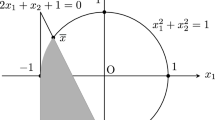Abstract
For an environmental system described by a system of nonlinear first-order differential equations, the problem of achieving specified terminal conditions in a given time with a minimum expenditure of resources is considered. The initial conditions and the minimum value are found numerically in a particular example.
Similar content being viewed by others
Literature
Huddleston, John V., C. G. DeWald and H. N. Jagadeesh. 1974. “A Dynamic Model of an Environmental System withn Interacting Components andp Degrees of Freedom.”Bull. Math. Biology,36, 91–96.
Pielou, E. C. 1969.An Introduction to Mathematical Ecology. New York: Wiley-Interscience.
Rescigno, A. and I. W. Richardson. 1973. “The Deterministic Theory of Population Dynamics.” InFoundations of Mathematical Biology, Rosen, R., ed. New York: Academic Press, Vol. III.
Author information
Authors and Affiliations
Rights and permissions
About this article
Cite this article
Huddleston, J.V. Optimality in the control of environmental systems. Bltn Mathcal Biology 36, 341–345 (1974). https://doi.org/10.1007/BF02464612
Received:
Issue Date:
DOI: https://doi.org/10.1007/BF02464612




